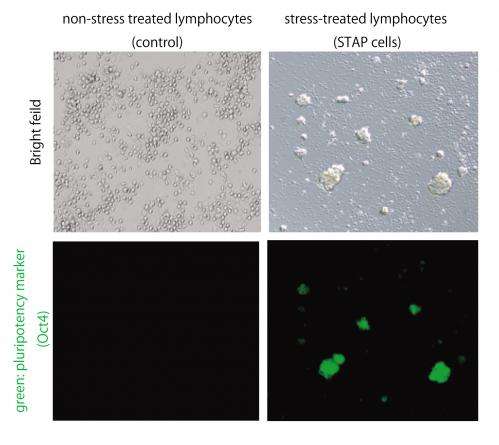February 18, 2014 report
Image anomalies cast shadow on acid-bath stem-cell study

(Phys.org) —Japanese research center RIKEN has opened an investigation, Nature is reporting, related to reports of anomalies with images published in the same journal as part of a paper on a revolutionary approach to generating stem cells.
The paper, titled "Stimulus-triggered fate conversion of somatic cells into pluripotency" described an acid-bath approach the team used to generate the type of stem cells that can grow into any body part. The approach was so much simpler than current methods that it created quite a stir in biology labs across the world. Soon after publication of the paper last month, however, comments began appearing on science blogs noting what appeared to be anomalies or inconsistencies with some of the images that were published along with the paper. Some suggested that one image had been spliced, others that parts of a placenta shown in one image may have been reused in another. As questions about the images used in the paper have grown, it appears that RIKEN, the institute where lead author and researcher Haruko Obokata works, has decided to look a little deeper to find out what is going on.
Complicating the issue is that several research organizations have reported that they have thus far been unable to reproduce the results claimed by Obokata et al, though all have acknowledged publicly that they have not used the same types of cells in their experiments and that while the procedure sounds relatively straight forward, it's actually very difficult to carry out.
Problems with images in a research paper don't necessarily mean there are problems with the research, as other posters have noted. It could be simple communication problems between writers and/or the publisher. One of the authors listed on the paper, Charles Vacanti, told Nature that he believes the image problems are due to a mix-up of some sort during the publication process—he's requested a correction.
For its part, Nature, in posting an announcement about the move by RIKEN, appears to be taking the wait and see approach—they note that the image inconsistencies appear to cast doubt on the paper as a whole, but refrain from commenting on its own vetting process as it applied to the paper it published. Obokata has not responded to queries from Nature or anyone else, though she and her team are reportedly working to uncover the source of the problem with the images and will be publishing a reply in Nature at some point.
Journal information: Nature
© 2014 Phys.org




















